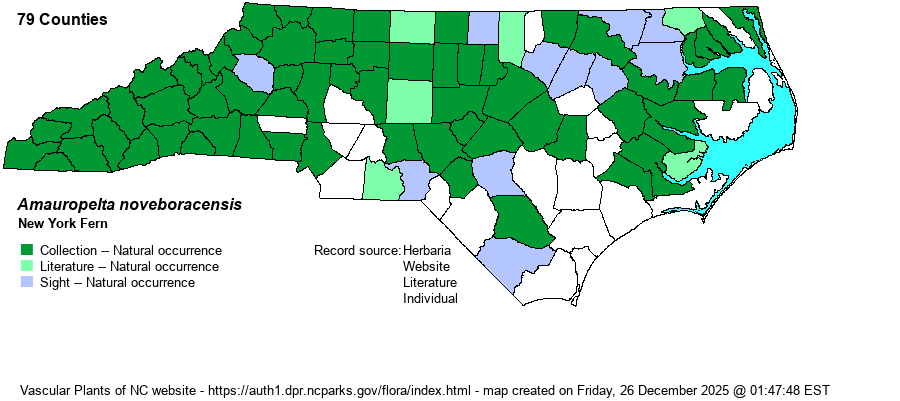| Author | (Linnaeus) S.E. Fawcett & A.R. Smith | |
| Distribution | Essentially throughout the state, but rare in the Sandhills proper and nearly absent from coastal counties and much of the southern Coastal Plain. For some unknown reason, the species has been poorly collected from much of the northeastern Piedmont and northern Coastal Plain, despite numerous sight reports.
This is a widespread species in the East, found in most counties in its range, from eastern Canada south to central GA and LA. | |
| Abundance | Common in the Mountains; fairly common to common in the Piedmont and the northern half of the Coastal Plain, but rare to uncommon in the southern Coastal Plain (and there mainly along brownwater rivers). It seems to be increasing in the eastern Piedmont and Coastal Plain in recent decades, as the sightings without collections imply, or simply that populations are being found with additional survey work. | |
| Habitat | This is a species of moist, somewhat rich forested areas. It does not require high pH soils, and can be found widely in bottomland forests, on lower hardwood slopes, in bogs, in wooded seepages, and other moist shaded places. However, into the Coastal Plain is it more limited to higher pH soils of rich brownwater bottomlands and lower slopes. |
| Phenology | Fruits from May to August. | |
| Identification | This is a familiar fern over most of the state and is easily identified by its odd blade shape. The stipe is generally 5-6 inches long, with a narrowly elliptical blade outline, the blade being about 15 inches long and 5 inches wide on average. The blade is pinnate-pinnatifid, such that the numerous pinnules on a pinna are oblong with a rounded tip, and not quite separated from the next one by a sinus cut to the midrib. The 20-35 pairs of pinnae are mostly opposite, with the longer ones in the middle, about 2-2.5 inches long, but those toward both the apex and the base are shorter, such that the blade has an even taper at both ends, like no other fern species. (Many taper to the apex, but none taper gradually to the base of the blade like in this species.) There are about 10 rounded sori beneath each pinnule. | |
| Taxonomic Comments | Older references mainly named the species as Thelypteris noveboracensis, in the same genus with Marsh Fern (T. palustris), but some had it in the genus Dryopteris. It has been moved around from genus to genus in recent years; in 2021, a revision of Thelypteridaceae by Fawcett and Smith has now moved it to the genus Amauropelta.
| |
| Other Common Name(s) | None | |
| State Rank | S5 | |
| Global Rank | G5 | |
| State Status | | |
| US Status | | |
| USACE-agcp | | |
| USACE-emp | | |

